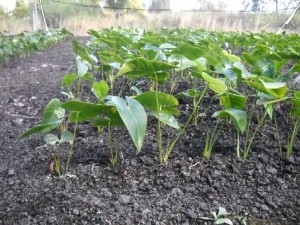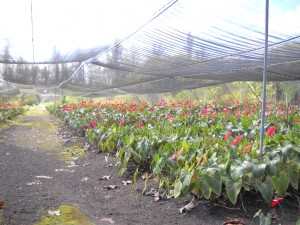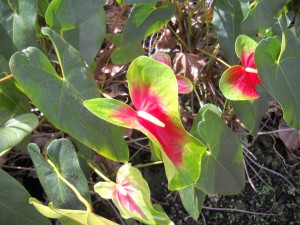Anthurium Plant Problems
Many anthurium plant problems are easily avoidable and can be avoided by following a few simple anthurium care guidelines. Today I am going to talk about the problems that can be caused by giving them too much or too little water, exposing them to incorrect temperature ranges, and providing them too much or too little light.
Watering
Anthurium plants like water but they also like it when their roots can breathe. Water them regularly or they will be stunted or even die. But water them too much and they will experience root rot, have their leaves turn yellow and eventually die.
There are two secrets to watering them.
The first secret involves a lot more work than the second, so it is more prone to resulting in over or under watering. It is to always check the potting media before watering. If it’s soaked, then wait a while before watering. You want to water your plant before the media becomes bone dry and after it is no longer soggy. There should still be a hint of moisture or the roots of your plant will go into shock, and the roots will struggle to absorb water again.
The second secret is to do what we do on the farm, which is to grow them in volcanic cinder. Cinder is a highly porous media that drains exceptionally well. So if you forget to water your plant it probably isn’t the media for you. But it drains so well that your plant can be watered daily without root rot as long as you remember to empty the drip tray that your pot is sitting in. You don’t even have to check if it is soggy; you just wake up in the morning and water your plant. By the following morning the cinder will have dried sufficiently for you to water your plant again, without fear of root rot.
Temperature
Anthuriums like most people don’t like extreme temperatures. Freezing weather will kill them. Hot weather, above 90 degrees, can burn their leaves and damage their flowers. Cold weather below 50 degrees can reduce their rate of growth and cause their leaves to turn yellow. They prefer to be kept at temperatures between 70 to 90 degrees.
Light
Excessive direct sunlight will burn the leaves and flowers of your plant. When left in strong sun, the leaves of your plant will start to turn yellow. If you don’t heed this warning sign, next the leaves will turn brown and die. Anthuriums can tolerate a fair amount of shade, since in their native habitat, they live under the highly shaded canopy of a rain forest, but too little light can cause stunted growth and a decrease in flower production. So if this starts to happen to your plant, give it a little more light.
Anthurium Flowers and Plants
ANTHURIUMS are one of the most beautiful flowers in the world. ANTHURIUM FLOWERS are produced by ANTHURIUM PLANTS, which are members of the genus ANTHURIUM. This genus consists of over eight hundred ANTHURIUM SPECIES and hybrids like OBAKE ANTHURIUM. ANTHURIUM CARE is easy and consists of finding the right place to put them and watering them properly. HAWAII is one of the first places in the world to grow anthuriums commercially.
How To Take Care Of Anthurium Plants
Anthuriums produce the perfect flowers for Valentine’s Day and are excellent symbols of love, because they are shaped like hearts and they come in the color red. They make excellent houseplants and taking care of anthurium plants isn’t too difficult if you follow these tips.Water them regularly. You never want to let their soil get bone dry, but you also do not want to drown them either. If you let their soil get too dry, when you water them again they will have a difficult time absorbing water again. But if you do not allow the water to drain fully, they can suffer from root rot. Another component of proper drainage comes from the soil that your plants are potted in. If the soil doesn’t drain well, you should repot your plants into a potting soil that drains better.
Give them the correct amount of light. Direct sun light is bad for these plants, it can burn their leaves and flowers. Bright, indirect sun shine is best. If they do not get enough light, they will stop flowering and their growth will slow. Often you will see their leaves getting elongated and turning dark green if they aren’t getting enough light. So make sure that you give them the right amount of light.
To ensure that they grow evenly, turn the pot that they are planted in a little bit, once a week. These plants grow towards the sun and this will ensure even growth. If you watch them closely, you will see that they will orient their leaves and flowers to face the sun.
Clean your plants periodically. Spray a little water on the top and bottom of their leaves and use a soft cloth to wipe off the water. This will remove any pests and dust from your plants. This will help to keep them healthy and make their leaves look nice and shiny too.
Anthurium Fertilizer: A Guide To The Nutrients Required By Anthurium Plants
Like all plants, anthurium plants require certain nutrients in order to grow. The absence of these nutrients can cause your plants to grow slower or even die. Proper anthurium care dictates giving your plants the correct amount of each of these nutrients. This is a brief guide to these essential nutrients and the symptoms that you might see if your plant is deficient in them.
The three main nutrients required by anthurium flowers and all plants are nitrogen, phosphorus and potassium. Just about every fertilizer on the market contains these elements because they are vital to just about all plants. The lack of any one of these nutrients will usually cause the following symptoms to occur. First, you will notice stunted growth. Your plant will either grow more slowly or stop growing completely. Second, you will notice that the leaves of your plant will begin to turn yellow, and eventually the leaves will start to die. Finally, if nutrients are still not provided, your plant will die.
Magnesium is another vital nutrient. Without it, your plant will be stunted and its leaves will begin to turn yellow and start dying. In addition, a lack of magnesium will cause new leaves to be deformed. Calcium is also very important. Lack of calcium can cause the flowers of your plant to die. Calcium deficiency will cause new leaves to be deformed and will also distort the edges of mature leaves. If the deficiency continues, the leaves will start turning yellow and begin dying.
Sulfur is another important nutrient. Lack of sulfur will result in slight stunting of your plant and slight yellowing of its leaves. Your plant may be able to survive a sulfur deficiency, but why take any chances?
Probably the easiest way to resolve these deficiencies is to use a complete fertilizer. If you look around your garden store, you will be able to find something that has all of these nutrients in slow release form. In most cases, this should be all you need. But some severe cases of calcium and magnesium deficiencies may warrant the use of dolomite. This contains both calcium and magnesium.
Anthurium Pests: Mortal Enemies Of Anthuriums
Anthurium plants are tough, but just as Superman has his weaknesses, so do anthuriums. As long as you follow the basic principles of anthurium care, your plants should be able to shrug off the majority of problems. However, even with the best of care, anthuriums can succumb to the following pests.
Anthracnose is a fungal disease caused by Colletotrichum gloeosporioides. Usually it is not deadly, but it is a great nuisance. When it infects your plants, it causes brown splotches to form on the spadix of your flowers. Sometimes this can cause the spadix to die off completely and start to rot. So if you want nice flowers you need to avoid this disease. You can do this by only raising anthracnose resistant varieties or by using any of a number of fungicides to keep it under control.
Nematodes are small worms that attack the roots of your plants. They burrow into the roots and as they are burrowing they are also feeding on the roots. This causes the roots to grow slower and keeps your plants from growing. They can kill your plants, but more likely will only cause them to be stunted. Fortunately, they can be eliminated with various agricultural chemicals.
Another grave threat is a group of fungi, which include: Pseudomonas, Colletotrichum, Rhizoctonia and Phytophthora. They are essentially parasites that live by consuming your plants. Left unchecked, they are deadly, but there is a lot that you can do to keep them at bay. They like water and low oxygen levels, so do your best to not give them what they want. Your plant likes water too, but just be sure that you don’t water it excessively. And if they are still a problem, any one of a number of fungicides can be used.
By far, the greatest enemy that your plants face is Xanthomonas blight. It is the most diabolical of threats to these plants. It kills nearly all plants that are misfortunate enough to get infected with it. It is a bacteria that is transported from plant to plant by water. If it finds the tiniest scratch on a flower or leaf, it will enter and begin attacking your plant. If you are lucky, you can remove the infected leaf and your plant may live. But if it reaches the core of your plant, the odds of your plant surviving are low. There are no known treatments for blight. It is generally a death sentence for any infected plant.
Anthurium Blight: How To Keep The Deadly Anthurium Blight At Bay
Some but not all anthurium flowers are susceptible to a disease called Xanthomonas blight. The blight is deadly. It doesn’t take any prisoners. When an anthurium plant is infected it will eventually die, unless you manage to remove infected leaves or flowers before the disease has spread. Generally, andreanum are susceptible to this disease, while andrecola, which are andreanum amnicola hybrids are resistant to it. So if you are growing andrecola you probably don’t need to worry about blight, but if you are growing andreanum, you might wish to read on.
Proper anthurium care is vital to keep this threatening menace at bay. Blight is spread by water and proximity. Water can carry Xanthomonas from an infected plant to an uninfected plant.
Obviously if you keep the plants close together, there is a greater chance of infection than if you keep them far apart. So if you are growing these plants in your garden you want them spaced as far apart as possible. But if you are a large quantity of them, you may not have a choice but to keep them closer together.
When growing these plants in close proximity there are several things you can do to reduce the transmission of blight. The first is changing how they are watered. Watering with drip irrigation will reduce the amount of water that gets on the leaves. This will reduce the transmission of blight from an infected leaf to an uninfected one. Second, immediately remove any plants that show signs of infection. Be careful not to let it touch other plants as it is carried away. Third be careful when walking in between your plants, especially if they are wet. You can easily spread blight when they are wet.
Finally, proper sanitation is essential. Make sure that there is no standing water where you grow your anthurium. Sterilize all pots and tools before use. Rubbing alcohol can be used as a sanitizing agent. Clear away any dead leaves. And make sure you quarantine any new plants for a while to make sure that they are uninfected.
Anthurium Pruning: How To Prune Your Anthurium Plant
If you have had your anthurium plant for a long time, you may want to consider pruning it for several reasons. First, if your anthurium has a lot of dead or yellow leaves they should be removed. Second if a leaf or flower has been injured by a pest and become infected it should also be removed. Third, if your plant has an excess of leaves, it can be pruned for aesthetic reasons.
To start make sure you have the following supplies on hand. You will need pruning shears, a cloth and rubbing alcohol. Put a little alcohol on the cloth and rub it over the blades of your shears to sterilize them. Sterilization is a very important step that is required to keep your plant disease free.
Next, look for any dead or yellow leaves on your plant. If you find any, gently pull them off. If they do not come off easily clip them off with your shears near the stalk of your plant. After each cut be sure to sterilize your shears to prevent the spread of bacteria to your plant.
After that, look for diseased leaves and flowers, and clip them off. Make certain you are especially careful to sterilize your shears when working with diseased portions of you plant. But, hopefully you will be lucky and not have any diseased leaves or flowers to trim off.
At the end of your plant’s growing season, you can remove leaves for aesthetic reasons if your plant has more than four leaves. If you wish, you can trim off any excessive leaves that stick out at bad angles to make your plant look better. But when you are doing this make sure you leave at least four leaves or you may harm your plant. When doing this try to remove older leaves and leave the younger leaves to develop further.
Anthurium Problems: Common Problems Faced When Growing Anthurium Plants
Usually anthurium plants are very easy to grow, but sometimes you may encounter a few of these common problems when raising them. Most of the problems you will face when growing anthuriums will be the result of errors in watering, fertilizing or light levels. When growing anthuriums outdoors, pests can also be an issue, but I assume that most of you will be growing your plants indoors, so I am not going to cover pest issues.
The number one cause of problems has to do with watering. Improper watering can permit fungus to attack your plant and so it can be indirectly responsible for harming your plant. Fungus and other anaerobic bacteria grow well when air is not allowed to reach the roots of your plant.
Over watering and the use of a soil that doesn’t drain well are common issues. If your plant has stopped growing and has started producing wilted leaves, you may have a problem with fungus. You may be able to fix this by repotting your plant into a soil that drains better and by being careful not to over water your anthurium. When repotting, you may need to trim off the diseased or damaged parts of your plant.
Another big issue is over fertilizing your plant. If your plant is turning yellow or brown, it could be receiving too much fertilizer. Stop adding additional fertilizer and try to rinse out the excess fertilizer with water.
Finally, too much or too little light can also cause problems. If your plant seems to be growing slowly and producing few flowers, this could mean that it is receiving too little light, especially if its leaves are dark green. Try moving your plant to a brighter area, but never put it in direct sunlight. If your plant is getting bleached and the tips of its leaves are turning brown, it may be receiving too much light. Try moving it to an area with a little less light.
How To Plant An Anthurium In A Pot
This is another article in my series of articles on anthurium care. In this article, I will discuss how to plant an anthurium in a pot. If you want to pot an anthurium, there are several things that you need to keep in mind.
First you need to consider the size of the plant that you wish to pot. Is it coming from tissue culture or a top cutting? In general, tissue culture plants are tiny, so you can use a small two inch pot. But if you are taking a top cutting, you could be dealing with a medium to a large plant. So you may need a pot that is anywhere from four inches to twelve inches in size.
Second, you need to use the proper growing media. The most important factor when choosing a growing media is that it drains well. Excess water can allow anaerobic bacteria or fungus to grow. These organisms can kill your plant, so you have to make sure that the growing media does not hold excess water. Anything that adds porosity to your media works. You can use perlite, sand, gravel, wood chips, volcanic cinder or pumice.
Third, now that you have settled on a pot and the growing media, you will need to pot your plant. Take a scoop of growing media and put it on the bottom of the pot. Next, put your plant into the pot and put additional media into the pot, around your plant. Stop once you have filled the pot almost to the brim. Add a small dose of slow release fertilizer and that should do it.
Now that you have finished potting your plant, give it a thorough watering to allow the soil to settle and to hydrate your anthurium. Next, find a bright spot that is out of direct sunlight to put your newly potted anthurium. Finally, make sure that your plant doesn’t get to hot or cold: it is especially vulnerable after being potted. And make sure that you water it regularly.
Obake Anthurium: How To Fertilize An Obake Anthurium
Obake Athuriums produce some of the biggest and most beautiful anthurium flowers. Their flowers are much bigger and wider than regular anthuriums and they are also much more colorful. Usually they will produce flowers that have two or more colors. If you have a prized obake anthurium and you want it to produce the biggest and best flowers that it is capable of producing, this is what you need to do.
Sure, you could take the easy way out and utilize slow release fertilizer, and just apply it twice per year and be done with it. This is simple and easy to do. But this will not enable your plant to live up to its full potential. Doing this will keep it healthy and allow it to produce reasonable flowers.
If you want your plant to produce the best flowers that it is capable of producing, you need to use an approach that takes a lot more work. But if you have a highly prized plant the extra work will be worth it, when you see your plant growing well and producing amazing flowers.
What you need to do is feed it with liquid fertilizer. You will need to dilute the liquid fertilizer to roughly ten percent of the strength recommended on the label and you will need to apply it every week on a consistent basis. Make sure a little fertilizer gets poured on your plant’s leaves and stalk, in addition to its roots, because your plant can absorb nutrition through these areas too.
Watch out if the leaves on your obake anthurium plant turn yellow or brown, as this is a sign that it is getting too much fertilizer. If this happens, flush out the fertilizer with a dose of water and reduce the amount of fertilizer that you are applying. If you follow this routine consistently, your plant will grow faster and produce bigger and better flowers.








